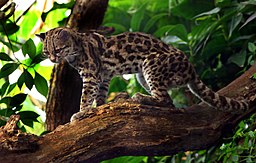Sierra de las Minas
| Sierra de las Minas | |
|---|---|
| Highest point | |
| Peak | Cerro Raxón (Alta Verapaz) |
| Elevation | 3,015 m (9,892 ft) |
| Coordinates | 15°09′47″N 89°51′05″W / 15.163063°N 89.851255°W |
| Geography | |
| Country | Guatemala |
| State/Province |
Alta Verapaz, Baja Verapaz, El Progreso Department, Zacapa, Izabal |
| Range coordinates | 15°10′00″N 89°40′00″W / 15.16667°N 89.66667°WCoordinates: 15°10′00″N 89°40′00″W / 15.16667°N 89.66667°W |
| Sierra de las Minas biosphere reserve |
|
| VI | |
|
The reserve has a significant Margay population
|
|
| Country | Guatemala |
|---|---|
| Region | Alta Verapaz, Baja Verapaz, El Progreso Department, Zacapa, Izabal |
| Highest point | Cerro Raxón |
| - elevation | 3,015 m (9,892 ft) |
| Lowest point | |
| - elevation | 150 m (492 ft) |
| Area | 2,408 km2 (930 sq mi) |
| Biome | – Subtropical thorn forest – Premontane dry subtropical forest – Premontane tropical wet forest – Lower montane subtropical moist forest – Cloud forest |
| IUCN category | VI - Managed Resource Protected Area |
| Website: Defensores de la Naturaleza | |
Sierra de las Minas is a mountain range in eastern Guatemala, extending 130 km west of the Lake Izabal. It is 15–30 km wide and bordered by the valleys of the rivers Polochic in the north and the Motagua in the south. Its western border is marked by the Salamá River valley which separates it from the Chuacús mountain range. The highest peak is Cerro Raxón at 3,015 m. The Sierra's rich deposits of jade and marble have been mined throughout the past centuries. These small scale mining activities also explain the name of the mountain range.
The range has several different habitats, including Mesoamerica's largest cloud forests, and is home to a great variety of wildlife. A large part of the Sierra de las Minas was declared a biosphere reserve in 1990.
In 1990, a substantial part of the Sierra de las Minas (2,408.03 km2 or 929.75 sq mi, including buffer zones and transition areas) was designated a biosphere reserve.
Due to its size and great variety in elevation and precipitation, the range has many different habitats and land cover types, including:
The reserve has 885 species, about 70% of all species found in Guatemala and Belize, including threatened birds like the resplendent quetzal (Pharomachrus mocinno), harpy eagle (Harpia harpyja) and horned guan (Oreophasis derbianus).
Felines with a significant presence are the Jaguar (Panthera onca), Cougar (Felis concolor), Onza (Puma yagouaroundi), Ocelot (Leopardus pardalis) and Margay (Leopardus wiedii).
...
Wikipedia


